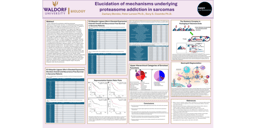The International Clinical Trials Methodology Conference - ISRCTN on the road in Edinburgh!
Published in Healthcare & Nursing, Biomedical Research, and General & Internal Medicine

At the end of September, the 7th edition of ICTMC was held at the Edinburgh EICC, giving researchers and practitioners from across the world a chance to meet and discuss developments over the past two years in clinical trial methodology since the previous conference.
We headed up to Scotland to represent ISRCTN, the UK’s clinical study registry, and BMC’s Medical Evidence portfolio, which includes Trials and Research Involvement and Engagement, two journals which delegates were particularly excited to talk about.

Some of the key themes of the conference and discussions from the booth are rounded up below.
What’s your transparent clinical trials priority?
We came armed with gold star stickers and a poll asking delegates “what’s your top priority” for transparent clinical trials, which sparked some really interesting chats about researchers’ considerations when registering and publishing their studies, and around how the concept of registering clinical studies should be considered a living, evolving part of the medical evidence record rather than a box ticking exercise.
The leading category switched between Open Access publication, publishing protocols, and data sharing throughout the week, but we had some honorable mentions from the ‘something else’ section including replications of results, providing open source code, and publishing statistical analysis plans.
Here’s how the poll looked after three days of intense voting (note that the Data Sharing voters loved neat rows!):

Greener Clinical Trials
One of the key themes within the conference sessions was sustainability within clinical trial design and management, and I was also fortunate enough to meet a few of the key researchers working in this area to discuss how we can encourage researchers to consider their trials’ carbon footprints when registering with ISRCTN.
Discussions in sessions and at the booth included:
-
Taking a visual approach to considering carbon footprinting of trials, using Trainline’s example of illustrating how customers illustrated comparisons of how much CO2 they saved travelling by train compared to car and air

- What funders are currently asking researchers to report on in terms of sustainability, and how journals and clinical study registries can support researchers using guidance on calculating emissions
-
Challenges in developing tools to measure the carbon footprint of trials include the fact that different countries have different emissions for the same activity. For example, producing paper has vastly different emissions from country to country depending on manufacturing method, deforestation impact, transport etc.:

- The overall sentiment amongst sustainable trial researchers is that in the same way as Patient & Public Involvement has become embedded as a natural consideration for trial design, considering sustainability throughout will also be the default within another two years.
Accessible Plain Language Summaries
During the conference, I was given the opportunity to present a poster on a study I’d put together on the quality and easy readability of Plain Language Summaries for trials registered on ISRCTN.

I compared how easy ISRCTN trials’ summaries were to read, with how many people read the published results article, and the altmetrics score of the published results articles, showing how many people had written news articles, posted blogs, and spoken on social media about the research. The data showed that while a good quality Plain Language Summary doesn’t have any impact on how many people read a results article (ie. how many researchers come across the work), it does have a correlation with how many people talk about it in blogs, news articles and on social media. This means that plain language summaries are doing their job and having the desired effect - a clear, well-written summary will reach more patients, carers and members of the public whose lives may be affected by the research.
This sparked some really interesting discussions with researchers, including a debate around why researchers find it so hard to write a good plain language summary, and whether patients should be involved in auditing, re-writing or advising on these to make them more accessible.
The full poster is available here. This was my first time presenting a conference poster and it was a really fun experience seeing the lengths researchers go to to make their posters stand out. My personal favourite was a delegate who’d crocheted a QR code for her poster into a cardigan!

Revised CONSORT and SPIRIT guidelines
Professor Sally Hopewell ran a really interesting session talking through the upcoming changes to the SPIRIT and CONSORT guidelines.
The SPIRIT guidelines form a checklist covering evidence-based recommendations on how to report interventional trial protocols. They were originally written in 2013.
The CONSORT guidelines date back to 2010, and cover how to report the results of randomised trials.
The shared aim for both of these guidelines is that ‘researchers should not have to infer what was probably done, they should be told explicitly’, a concept which was drawn from a quote by the late Professor Doug Altman, founding Editor-in-Chief of Trials from BMC’s Medical Evidence portfolio. While researchers cannot control their results, they can at least control how they are reported.
A working group including present and previous ISRCTN board and advisory members have been updating the SPIRIT and CONSORT guidelines, for the first time in over 7 years. They collected well over 2000 comments on this, and held meetings with 30 people covering various different end user groups to make decisions.
SPIRIT has had one new item added, detailing how patients and the public were involved in trial design.
CONSORT has seven new items added, covering:
- Data sharing
- Financial conflicts of interest
- Patient and public involvement
- Eligibility criteria for trial sites and for individual participants
- How harms were assessed
- Who is included in each analysis and each group, and how missing data is handled
- How interventions were actually delivered, and whether concomitant care was given
Some other items were revised or deleted, and a new section on Open Science has been added to their introductions.
The revised guidance is due to be published in late 2024 or early 2025, with a statement paper published across 5 journals, as well as an explanation and elaboration paper and the expanded checklist itself.
Overarching thoughts
This was my first time at ICTMC! Having attended quite a few massive (30,000 delegates) and tiny (100 or fewer delegates) conferences in the past, it was really refreshing to come to a conference where there was a good amount of relevant talks to go to, without a complete overwhelm of concurrent sessions. Everyone we spoke to at the BMC booth was very enthusiastic, and came armed with such interesting suggestions and ideas. We’re already looking forward to ICTMC 2026 in Birmingham!
Follow the Topic
-
ISRCTN registry

A primary clinical trial registry recognised by WHO and ICMJE that accepts studies involving human subjects or populations with outcome measures assessing effects on human health and well-being, including studies in healthcare, social care, education, workplace safety and economic development.
Your space to connect: The Primary immunodeficiency disorders Hub
A new Communities’ space to connect, collaborate, and explore research on Clinical Medicine, Immunology, and Diseases!
Continue reading announcement




Please sign in or register for FREE
If you are a registered user on Research Communities by Springer Nature, please sign in